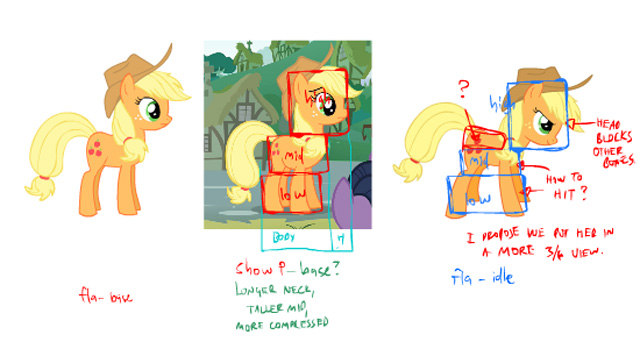This game should not exist. The concept is just too absurd: ponies, in a fighting game? And not just any ponies, but cartoon ponies whose sole purpose is looking cute and teaching viewers about cooperation and friendship? Making them fight is a blatant contradiction that completely undermines the spirit of the show. It must be the work of an overactive fan base with too much free time.
Perhaps there is some truth to those sentiments. But the crazy thing is that against all odds, reason, and expectation, the game does exist. Fighting Is Magic, an independently developed fighting game inspired by the cartoon series My Little Pony: Friendship Is Magic, is real, and through the sheer determination of its developers, it's getting better every day.
It is also an easy game to pass up if you, like me, are distracted by the all-pony cast. I remember walking the floor at last year's Evolution Championship Series and spying Fighting Is Magic for the first time. Through my facial expressions alone, you could have charted my reactions all the way from "What!?" to "They can't be serious." But I was wrong. MANE6, the team behind Fighting Is Magic, was very serious: about ponies, and about building a quality game.
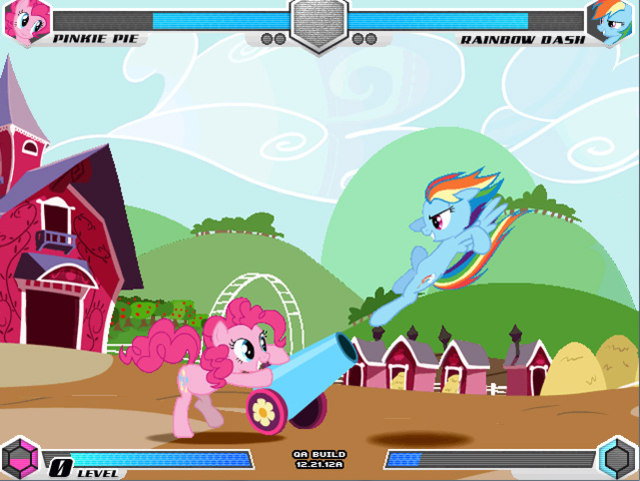
Part 1: Fighting is Magic
A few months later, after a second (and more open-minded) viewing, it all clicked. Each fighter had her own distinct fighting style. The animations were smooth and full of personality. And…did that pony just bust out an off-the-ground combo? In one and a half years, MANE6 has managed to execute a level of quality far exceeding any reasonable expectations.
Of course, reaching that level has not been easy. This was a group of fans first, and creators second. Between them they had precious little experience developing a game of any sort. Add in the fact that some of them were balancing full-time jobs, and all of them were paying for this out of pocket, and it becomes a wonder this game made it past a week. How did they do it, and what can this most unlikely of fighting games tell us about the genre? That story begins with a few silly pictures.
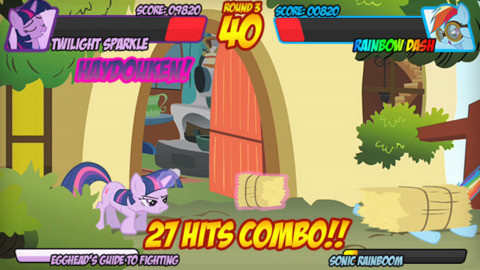
Well, technically, it begins with the cartoon. In the My Little Pony: Friendship Is Magic series, six talking ponies work together to discover the true meaning of friendship. They sing, throw parties, and explore the peaceful, pony-filled countryside of Ponyville. With their bright smiles, and brighter attitudes, the last thing you would expect is for these ponies to start throwing punches. However, it seems that fighting, much like friendship, holds a little magic of its own.
That magic manifested as some mock screens, shown above, for Marevel vs. Clopcom (get it?), the forerunner to Fighting Is Magic. According to their creator and future MANE6 team member, Anukan, "I never intended those screenshots to be taken seriously. I invested a total of 15 minutes and 16 seconds between getting the idea of making them from a comment on Ponibooru to the actual first execution. I look back at the horrible, tutti-frutti combo of a GUI I made for that and wonder who spiked my punch."
These images, along with several others, were posted to the My Little Pony: Friendship Is Magic image board, Ponychan, in a thread discussing the finer points of fighting ponies. For a select few, the idea became more than just a passing joke. One user in particular--Nappy--recognized the potential in this idea and in the creativity of the pony community. His determination to see Fighting Is Magic realized would be instrumental in the formation of MANE6.
During the summer of 2011, the group's six founding members met for the first time on Skype to discuss how two cartoon ponies would beat each other up. Alongside Nappy were Jay Wright, Lucas Ellinghaus, Anukan, James Workman, and Prominence. Together, they had lots of enthusiasm and big ideas, but only an amateur knowledge of game development and the fighting genre. Some had a few game mods and high school projects under their belt, but nothing on the scale of Fighting Is Magic.
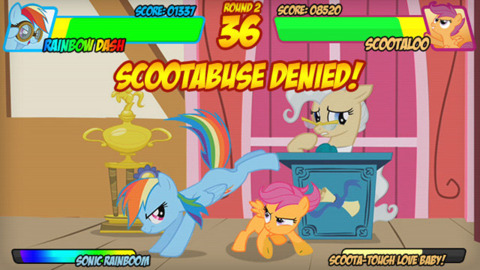
They also had zero knowledge of their chosen game engine: 2D Fighter Maker 2002. Therefore, the first two weeks of development were spent reading tutorials (which were scarce) and experimenting. It was slow, methodical work, but gradually the pieces began to fall into place. One pony could slap another, and some health would go away. This was a good start, and it demonstrated that MANE6 could--at the very least--make a really boring fighting game. The challenge then became making it a good game, and that began with wall bounces.
"When we started messing with physics and making things bounce off of walls," recalled Nappy, "that's when my face exploded." If MANE6 could manipulate the engine to bounce a pony off a wall, they could take on the world. Fighting Is Magic could become more than just an imitation fighting game; it could actually be fun. "Having wall bounces really showed us the potential for both the game and the team," Ellinghaus said. "It was a very exciting time."
In the whirlwind weeks between the start of development and the release of the first trailer, Fighting Is Magic went through dozens of changes, revisions, and overhauls. The rigid limitations of the 2D Fighter Maker 2002 engine gave the young team plenty of headaches, but ultimately those restrictions--and their solutions--shaped the game into the smooth 2D fighter it is today.
"When we started messing with physics and making things bounce off walls," recalled Nappy, "that's when my face exploded." If MANE6 could manipulate the engine to bounce a pony off a wall, they could take on the world.
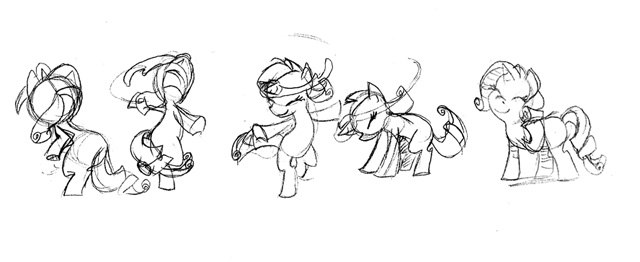
First, there was the matter of buttons. A two-button layout, a la Nintendo's Super Smash Bros., would be easy for people to grasp, but it didn't offer enough variation for the characters. A six-button configuration would have plenty of variation, but it could be too intimidating for non-fighting fans. Plus, the additional moves that would need to be designed and animated would create a mountain of extra work. This was, after all, a game MANE6 wanted to finish.
"We are catering to the fighting game community and the pony community at the same time," noted Ellinghaus. "These are traditionally two very separate communities, so we needed to find a balance that helps ease in new players while still having depth."
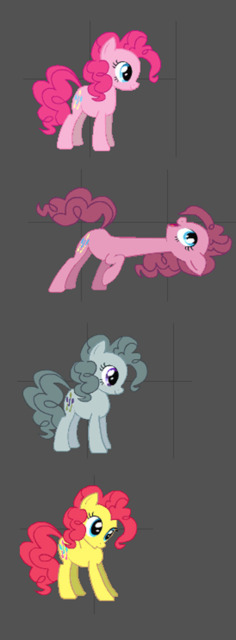
To that end, the team decided on a three-button system. Taking inspiration from Capcom's Vs. series, they knew they wanted chain-style combos in the game, so using a light, medium, and heavy attack layout was an easy conclusion. However, this layout revealed a serious problem.
"We also wanted a standard EX system," explained Nappy, referring to the mechanic seen in such games as Street Fighter IV where a character can execute an enhanced special move by inputting the command with two attack buttons instead of one. "But the engine had issues with certain input hardware configurations and would not detect simultaneous inputs unless they happened on the exact same frame." This made EX attacks extremely difficult to perform, so the team needed to find a work-around.
That search resulted in a fourth button: the magic button. And no, the magic button does not pull a rabbit out of a hat or do any nonsense using scarves. It simply condenses two button presses into a single input. At least, that's how it started, before it grew from a mere fix for hardware limitations into a tool for expanding the roster's fighting style.
"[The magic button] let us focus on what makes a character special," Nappy explained. "For instance, Twilight Sparkle likes to read; it's what she's known for. So pressing the magic button makes her read a book, which then refills her special meter because she is learning spells. She can then use that knowledge to unleash more-powerful attacks."
By the team's own admission, they are not "programming" the 2D Fighter Maker 2002 engine so much as "taming" it. There are rules that simply cannot be broken, but they sure can get bent and twisted in some interesting ways. However, even with the engine's limitations, MANE6 is grateful for the tools they have. "If we had started from scratch with our own engine, we would not nearly have the product we have now," admitted Wright. "We would be paralyzed by choice. Working in this engine has been a terrific problem-solving exercise for the team."
"It forces us to think laterally in that we have to create solutions that are not straightforward," said Anukan. For instance, the team wanted to make stages larger to discourage corner-carry combos, but the engine wouldn't allow it. So, instead, they gave characters the ability to roll after getting knocked down to help them escape the corner. "Sometimes we tame the engine, and sometimes it tames us."
MANE6's endless problem solving finally paid off with the release of the first Fighting Is Magic trailer. Uploaded to YouTube on June 19, 2011, the video was met with an overwhelmingly positive reaction, as described by its creators. It has since earned more than 900,000 views, and while some viewers simply "don't get it" or think the team is wasting its talents (a notably backhanded compliment), the trailer is considered MANE6's first major "hype milestone."
The fan response far outstripped the team's more conservative predictions. At best, they thought a small trickle of fans from within the pony community would take notice. What they got was a tidal wave--and not just from within the fandom. "We realized what we had in our hands and thought, 'Uh-oh, we really need to do this well,'" said Anukan. "[Fighting Is Magic] needed to be more than just fighting with ponies; it needed to be a competent fighting game that just happens to have ponies."
"To be honest, the pony aspect has been overtaken by the drive to make this a good fighting game," Wright said. "We have been overwhelmed by the validation from different areas of the fighting game community. It has been pretty amazing." Part of that validation came from an unlikely benefactor who helped thrust Fighting Is Magic into the cold, calculating eyes of the fighting game community at the Evolution Championship Series, the world's premier fighting game tournament.
"The pony aspect has been overtaken by the drive to make this a good fighting game. We have been overwhelmed by the validation from different areas of the fighting community."
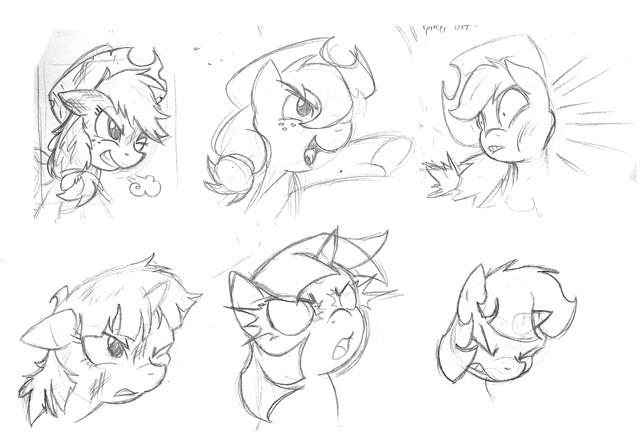
Being invited to EVO came as a surprise to the team. Granted, Fighting Is Magic had popped up a few times in threads on the Shoryuken forums, only to get shot down because of its pony trappings. Then the trailer hit, and the team noticed a stark change in tone. People began taking Fighting Is Magic seriously and discussing it not as a joke but as an actual fighting game.
Eventually, the game's buzz drew the attention of Mr. Wizard, one of EVO's organizers. His interest in the project was extremely motivational and informed the team that they must be doing something right. "EVO is the fighting game tournament. Period. And if one of the dudes running EVO thinks our fighting game is legit, then there's nothing anyone can say at that point."
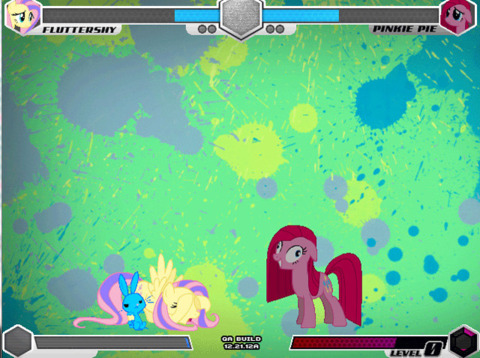
In fact, as Nappy recalled, "[Mr. Wizard] actually approached us." Before long, Nappy found himself giving a demo of the game over Skype. "At one point, I pulled off this really long Pinkie Pie combo, and he started giggling like a little girl. I don't think I can really explain the feeling I got from that moment--it was unreal. He was talking to me like [Fighting Is Magic] was a real game. He was completely serious about it, and he was enjoying himself."
In July of 2012--just over a year since the first trailer--Fighting Is Magic became an official part of the EVO 2012 indie games corner, alongside such games as Divekick and Super Comboman. This was a great opportunity for MANE6 to show off all their hard work, and while none of them were able to attend the show in person, they were able to monitor the community's response. The verdict was "pretty freaking positive" between the show floor demos and a monster live stream fabled to have lasted more than 10 hours. Slowly but surely, fighting fans were coming around to this implausible concept.
A few months later, in September, MANE6 had another opportunity to show their game to a much different crowd. Klisk Midori, friend of the team and founder of Canterlot Gardens--a dedicated My Little Pony: Friendship Is Magic convention--invited MANE6 to host a tournament at his show. This time, Nappy, Ellinghaus, Wright, and Workman were able to attend, as well as the game's two musicians: RC88 and Whitetail. Together they brought along an updated version of the game. Some miscommunication led to a delayed start for the tournament, but once everything was straightened out, the response was once again position.
And unlike at EVO, the team now had the chance to meet with their fans. They hosted a panel, gave interviews, and even signed a few autographs--much to their chagrin. "It was very flattering," said Wright, "but I want our game to get the attention, not us." This is not to say they were ungrateful--far from it. But with every new blog post, trailer, and public showing, the team pushed the boundaries a little further and risked drawing the proverbial Eye of Sauron.
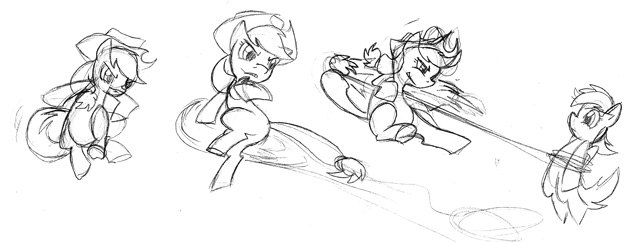
The threat of legal recourse from the show's producer, Hasbro Studios, against MANE6 has always been a very real--and terrifying--possibility. One letter, one complaint, and the team would have no choice but to cease development. Despite this, they remain optimistic. No donations or other forms of compensation have been accepted for this project--all expenses have come straight from the team itself. They have also been mindful of not violating the spirit of the show. There are no fatalities in this game or fountains of colorful pony blood. It is a fighting game, but everything is tempered in the whimsical nature of the My Little Pony universe.
"We know for a fact that the creator and producer of My Little Pony: Friendship Is Magic are looking forward to the game. Of course, that doesn't matter legally, so we're being very careful not to test the waters in any way," Wright said. "Hasbro has been very supportive of the creativity in the fan community, in all aspects. Plus, I think it helps that we're developing a game that would otherwise not exist at all."
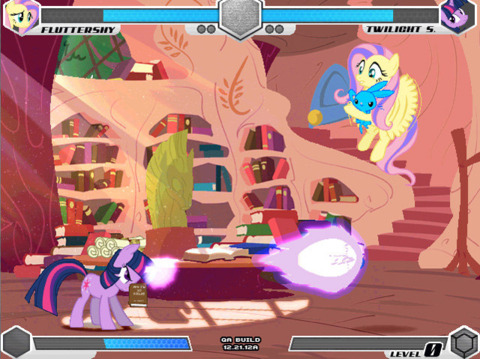
While Fighting Is Magic's luck continues to hold, other fan projects have not been so fortunate. In December of last year, the fan-developed online role-playing game MLP: Online was forced to cease operations after legal complaints from Hasbro. For MANE6, it was a somber reminder of the razor's edge Fighting Is Magic treads. As Wright noted, "I can't imagine how gutted [those developers] must feel right now." Even so, MANE6 is determined not to get bogged down with worry. Their motto is: If it's going to happen, then it's going to happen. Until then it is business as usual.
Should Fighting Is Magic ever be put out to pasture, the team knows it will not have been for nothing. Nappy and the others are confident they can take what they have learned developing this game and apply it to their next project--one that is not based on an existing franchise. As Ellinghaus noted, "In the best-case scenario we would like to make our own game next--using our own [intellectual property]. We actually have ideas for our next game already, and if we get the right people, we will start it. Working on Fighting Is Magic has taught us that these ideas aren't impossible anymore."
Make no mistake: fighting ponies is, and will likely always be, an absurd concept. But the fact that Fighting Is Magic exists is a healthy sign for the fighting genre. It demonstrates how vast and resourceful the fighting game community has grown. If the FGC can already independently execute a game on this level of quality, imagine all the potential left to explore.
Smaller, fan-driven projects such as this help keep the genre feeling fresh. Developing modern video games is an expensive business, and the Namcos and Capcoms simply cannot afford to take all of the risk and try all of the experiments they would like. But the community can, and it is learning--much like how MANE6 has--that these wild ideas are not impossible anymore.
By all odds, Fighting Is Magic should not exist--but I am certainly glad it does.
Since the publication of this article, MANE6 has ceased development on Fighting is Magic after receiving a cease and desist letter from Hasbro. They are now working on a new fighting game featuring a new cast by My Little Pony: Friendship is Magic creative director and producer Lauren Faust. For more information about MANE6 be sure to check out their official site and look them up on Twitter via @ManeSix.
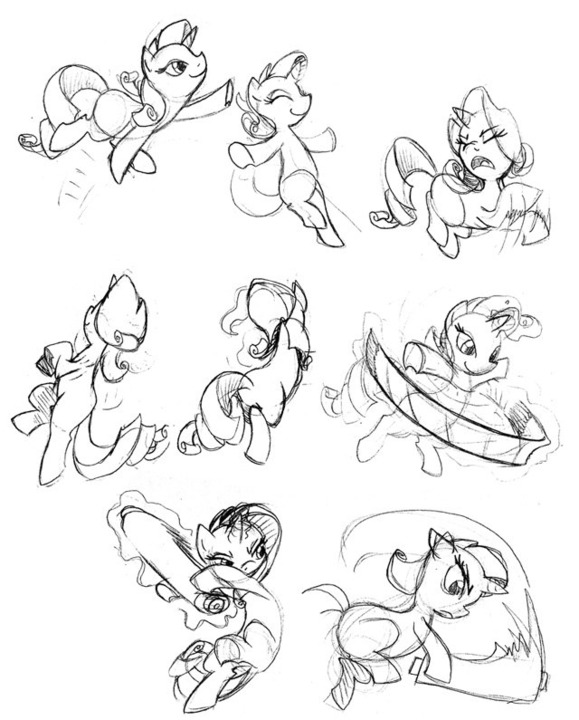
Part 2: Designing a Fighting Pony
Over the fighting genre's long and colorful history it has hosted plenty of outrageous warriors, from ancient gods to intergalactic aliens, and animals have been no exception. The Tekken series has its panda, Killer Instinct included a fighting velociraptor, and Teenage Mutant Ninja Turtles: Tournament Fighters…well, you get the idea.
Somehow, amid such outrageous combatants, a fighting game with an all-pony roster has remained absent in the lineup--until now. However, the process of turning these cartoon ponies into war horses has presented some interesting challenges for their young designers. The road from initial idea to finished fighter is filled with unexpected perils, and surprising solutions.
Step One: "Wouldn't it be cool if..."
This is the all-important brainstorming step. The team gathers around a shared document or open canvas to decide how a friendly pony would throw down in a fight. Every "wouldn't it be cool if…" idea is shared between them, within reason. MANE6 strives to match the tone of the cartoon as closely as possible. To that end, certain aspects of the ponies--such as their appearance and attitude--are set in stone. You're not going to see a hyperaggressive Fluttershy or a Rainbow Dash that only fights with projectiles. These restrictions help guide each pony's fighting style.
The team also looks outward to the numerous other fighting games available for character references. Seeing how other developers have interpreted the common fighting game archetypes accelerates the design process and can inspire new ideas. Once a pony's general play style is established, the challenge then becomes making that style unique. Referencing another character is fine, but copying one entirely is out of the question. The development of Fighting Is Magic's distinct magic button has gone a long way toward making its roster feel different from any other.
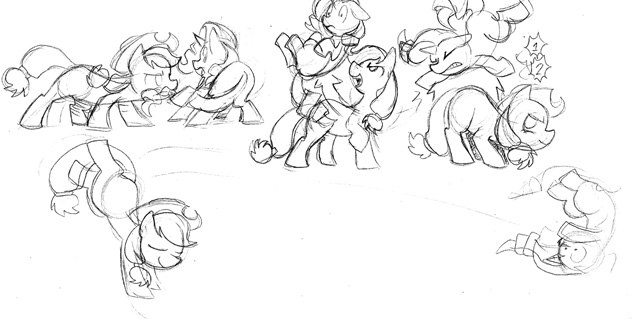
Step Two: Sketch Everything
Once a road map is in place for a character, the next step is sketching out each of those ideas in detail. Hit boxes are assigned during this time as well, showing which areas of an attack can actually harm the other player. An attack's special properties, such as between its standard and EX version, are also discussed. For characters such as Apple Jack and Twilight Sparkle, these designs come quickly. However, others can take a little longer.
"With Pinkie Pie," recalled Ellinghaus, "we had no idea what we were going to do with her."
"She has so many random motions," Nappy added. "Everybody saw her do a cartwheel during an episode and thought, 'Oh, that's the perfect move!' Except, we then have to build a whole moveset around that. How does she jump? What's her battle stance? We had to dig pretty deep in the show to find these ideas."
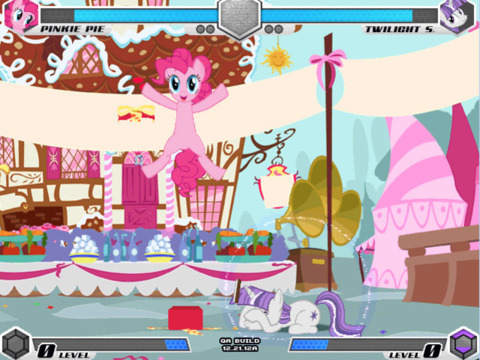
Every so often during their research, MANE6 finds one of their own ideas mirrored elsewhere. "For example," said Nappy, "Pinkie Pie has this move where she fires a present out of a cannon, and she can teleport out of the present as an attack.
After we got this idea in the game, Persona 4 Arena comes out and this Teddy dude has a move where he throws TVs--and then he jumps out of the TV--and I fell out of my seat! We thought we were so unique, but it is cool that we're thinking along the same lines of these top developers, even slightly."
Step Three: Individual Review
Before committing a character to production, the detailed sketches are sent out for another round of inspection. The designers check for redundant attacks and ensure that everything remains consistent with the pony's style. Ideally, each pony would need to go through this process only once, but as experience has shown, this is rarely the case. One of the most troublesome has been Rarity, a long-range fighter whose arsenal has seen more revisions than any other.
"[Rarity] was always seen as a zoning character," said Ellinghaus, "but our execution and direction for her needed heavy revision. In the beginning, nothing really fit together."
"She was more of a MOBA character than a fighting game character," Nappy added. "She had all these setups and situational attacks with her gems that required precise timing at the right angle. In the end, our testers only used her most straightforward attacks; the others just weren't worth all the trouble." In the end, after an eight-hour debate, it was decided that less was more in Rarity's case. Certain moves were nixed completely, while others were simplified. The team is confident these changes help focus her play style while maintaining some technical complexity.
Step Four: Flash Animation
This step is where the rubber hits the road. All moves have received the MANE6 seal of approval and are drawn up one by one in Flash. Early on in this process, the team discovered that animating attacks that felt powerful with a pony's physiology was going to be tricky. As Wright explained, since ponies lack the T-shaped torso and shoulders of a human, they cannot attack with the sweeps and rotations that make punches look painful. Plus, since a pony's legs and torso are the same color, certain attacks just looked like a mess of color.
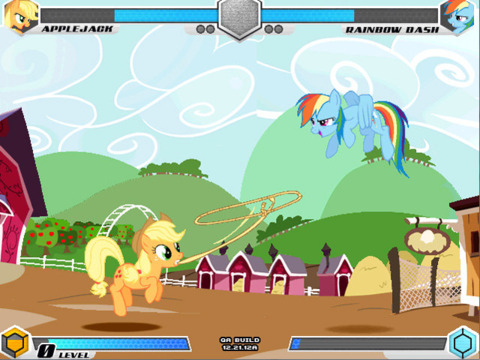
"Consider Ryu: His body is all white, his center is highlighted by a black belt, his hands are red, and his feet are skin colored. Because of [these details], you always know exactly where his attacks are coming from. With our characters, for example, there's a yellow blob with these sort of spaghetti noodle lines coming out of it, and the end of that line is supposed to have power somehow. I don't think we have succeeded 100 percent, but we have tried to make up for it using hit sparks and opponent reactions."
Step Five: From Flash to Fighter Maker
This final step is the long, difficult road each character must travel to make it into the game. It is an extremely complex, often heartbreaking journey as the vector-based, soft-edged images from Flash are made ready for the pixel-based, hard-edged world of 2D Fighter Maker 2002. As one of the team's animators, Wright has penned an extensive entry on MANE6's official site detailing how this is done. It is important to note that there is "some crying involved."
Once a character makes it into the game, the team can see if their attack designs--specifically the hit box layouts--work well in real combat. Naturally, the first few attempts didn't feel quite right and required extensive reshuffling. As Nappy explained, "When we drew up the hit boxes for these characters, they were basically square heads and huge rectangle bodies. When we put it in the engine, we found the game became very cross-up heavy. I don't think there has ever been a fighting game where the standard character design was this wide. That has been a fun challenge to play with."
Over the many months since this project began, the team at MANE6 has run through these steps more times than they care to admit. Mistakes have been made, moves scrapped, and characters completely reworked. But with every new challenge the team learns a little more about development, and becomes a little more proficient at their craft. Today, the end is almost in sight. "We're not on the homestretch yet," said Wright, "but we can see it. There are still hundreds of things we want to add, we just have to get them all in the game. We're almost there."
